Secrets of Disney's New 'Jungle Book': From Bleeding-Edge FX to Bill Murray's Brisket
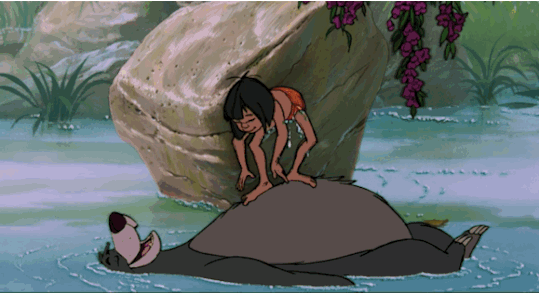
Baloo and Mowgli take a plunge in the original 1967 movie and in the new live-action version (Disney)
Disney is reopening the The Jungle Book this week. This time, director Jon Favreau’s photo-realistic animals are replacing the cartoon critters of the studio’s previous adaptation of Rudyard Kipling’s stories.
Earlier this month, Yahoo Movies spent some time with Favreau and several cast members — Neel Sethi (the 10-year-old newcomer who plays Mowgli), Ben Kingsley (Bagheera, the wise panther), Lupita Nyong’o (Raksha, the mother wolf), and Giancarlo Esposito (Akela, the leader of the wolf pack) — and got their exclusive first-hand insights into the creation of the film. Read on for their Jungle Book primer.
This isn’t a straight remake.
First things first: Moviegoers shouldn’t expect a scene-by-scene recreation of Disney’s beloved 1967 film, which is generally considered the last of the studio’s great animated features before The Little Mermaid ushered in a revival in 1989.
Related: Jon Favreau on Garry Shandling’s ‘Bittersweet’ Performance in ‘Jungle Book’
“People have such strong memories of the 1967 film — I know that I do. But if you translate that story to this medium, there’s an incongruity,” says Favreau. “There’s a balancing act between making this exciting action movie that people expect from a film of this size and also pay tribute and homage to what people remember from the ’67 animated film.”
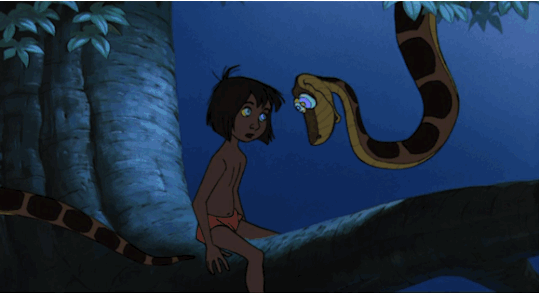
The 1967 version of Kaa versus the menacing new version (Disney)
The general structure of the story is the same: The man-cub Mowgli is found by the panther Bagheera and raised by wolves; once the fierce tiger Shere Khan arrives and demands they turn Mowgli over, Bagheera takes the boy from the jungle, ostensibly to bring him back to the human village. Favreau and screenwriter Justin Marks (who also wrote Disney’s upcoming 20,000 Leagues Under the Sea reboot) blended the familiar elements of the animated feature with material from Kipling’s original, darker tales.
Nonetheless, most of the characters from 1967 are here, although some in different form.
Mowgli remains a gangly man-cub, Shere Khan (menacingly voiced by Idris Elba) is the same terrifying tiger, and Bagheera is still a sleek black panther. But a few of the other creatures have been modified in the name of accuracy — at least as much accuracy as possible when you’re dealing with talking jungle denizens.
“We changed [King Louie, voiced by Christopher Walken] to a Gigantopithecus because orangutans don’t live in that part of the world,” explains Favreau. Gigantopithecus is an extinct great ape species whose fossil remains have been found in the Indian subcontinent, and who some have suggested inspired the legend of the Yeti.

A behind-the-scenes look at the creation of King Louie (Disney)
“The original film was a little male-heavy, so we changed the character of Kaa,” says the director of the film’s sinister serpent. “We thought that Scarlett [Johansson], who I’ve worked with a few times, would be perfect. Her voice is so emotive.”
And there was one additional change to a key critter: “The bear in the ’67 film feels much more like a brown bear, but it’s said to be a sloth bear in the Kipling, which is much more different in design.” So Bill Murray’s Baloo has been retooled accordingly.
Incidentally, unlike Walt Disney’s animators, who would travel into the field to observe animals back in the day, Favreau says that his crew didn’t need to journey very far. “We looked at a lot of clips on YouTube,” he says.
Yes, there are songs.
“There are musical moments, but this is not a musical,” says Favreau. “The original film felt so young. And the musical memories we have from that film — how does that fit tonally with a film that’s photo-real, where there’s real danger and emotional stakes?”
Related: Watch Bill Murray and His ‘Jungle Book’ Costar Neel Sethi Sing 'The Bare Necessities’
While we don’t have elephants singing a march or a quartet of Beatlesque vultures harmonizing a cappella, we do have a moment where Baloo and Mowgli reprise “The Bare Necessities” (“I got to record that with Bill Murray,” gushes Sethi). Christopher Walken also talk-sings “I Wan’na Be Like You (The Monkey Song).” If you stick around for the end credits, you’ll hear Walken croon a fuller version of the song (complete with new lyrics by original songwriter Richard Sherman), while Johansson coos a breathless “Trust in Me,” and Dr. John caps things off with his Dixieland take on “The Bare Necessities.”
This jungle owes a big debt to Pandora.
“We used techniques that haven’t been used since Avatar, and we built upon those… Jim [Cameron] came by the set, and he couldn’t have been more supportive,” says Favreau, who also counts Gravity, Life of Pi, Star Wars: The Force Awakens, and the recent remakes of Planet of the Apes and King Kong among the non-Disney influences on The Jungle Book’s technology.
More: From Maz Kanata to ‘The Jungle Book’ Lupita Is Here, There, Everywhere
He continues: “It starts off as a puzzle, as a curiosity, as a test of what can we do with these tools. And that’s the dance that happens in cinema. You want to tell a story, you can’t tell it, you build new tools to tell it. Whether it’s a piece of camera equipment or putting a mirror on the train tracks so you can see the train coming right at the camera without hitting the camera, it’s all illusionist tricks.
“It’s following in the footsteps of what Walt did. What Walt’s formula seemed to have been was to take the old stories, the old myths and then use state-of-the-art technology to retell them. We think of his work as very nostalgic but if you look back at Steamboat Willie, it was very technically advanced they way they married sound to picture.”
Favreau essentially made three movies.
“We had a cut of the film before we ever photographed it,” he says. “We did it first through our story team, like an animated film.” That means the actors recorded their lines which digital artists used to create a rough animation. “Then we motion-captured the whole thing like Avatar before we ever shot a frame of film. Then we went in and surgically picked out each piece of set we had to build to fit in to that motion-capture film. Each set was built for a specific shot.”
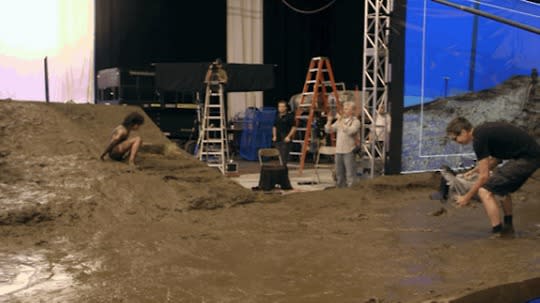
Sethi filming on a soundstage (Disney)
The jungle was constructed entirely on soundstages in downtown L.A. and didn’t feature a single real animal.
“There were puppeteers,” recounts Sethi. “They brought in puppets. What were they called, the Muppets… Benson?”
“Jim Henson Studios,” Favreau chimes in.
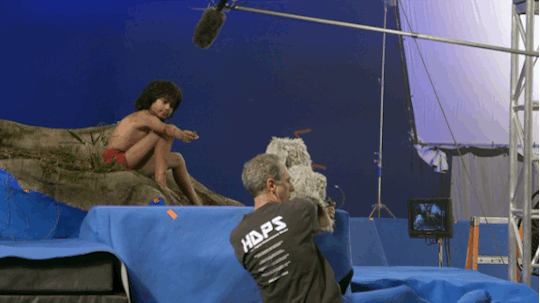
Sethi interacting with the animal puppets (Disney)
“Yes! Every day I would interact with those, and Jon got to do the puppets some times,” Sethi continues. “I had to train in parkour, but then they realized I jump around and do all that crazy stuff on my own already. They taught me a lot, though.”
Adds Favreau: “He did some training in New York with parkour teachers. He did some training here [in L.A.] with parkour instructors. And then I would meet with them to figure out what his capabilities were, and then we would design sets that measured out to what he was capable of, how large an obstacle he could vault, things like that. And they would start to drill him in it. And whether he knew it or not, he was being trained for the set that we were designing digitally.
“Now on the set, you would just see foam objects and things to climb over beams to balance on — all painted blue — but there was a digital environment that lined up exactly to that. And of course it was all much higher off the ground in the digital world. So it just looked like you were running around in a tumbling studio or on a jungle gym. And when you saw it in the Simulcam monitor, he’d be 100 feet off the ground precariously leaping from branch to branch.”
“I was only allowed to be 30 inches off the ground,” says Sethi.

How the treetop scenes were created (Disney)
Favreau was a man of many voices and species.
The voice cast never recorded all together. Many of the principals, like Elba, Johansson, Nyong’o, and Esposito, were alone with Favreau, who would read all the other parts. But whenever possible, the director would try to pair key actors opposite each other. The director figured Sethi needed to bond with Mowgli’s surrogate fathers, so the young actor spent time in a booth with Kingsley and Murray. Favreau also made sure to get the combustible pairing of Murray and Walken in a studio. “Try to get them in the room together as much as possible so they’re reacting to eye contact and taking pauses in harmony with one another,” explains Favreau.

Walken and Murray recording together (Disney)
“Even if the performer gives a stunning, one-take killer performance on a line of dialogue or a monologue, it still requires an animator to give it that human touch. The artists are touching every frame. … It’s really a hand-made film, but the toolbox is digital.”
Because Sethi was the only actor present on the soundstages for shooting, Favreau would act out various parts opposite the boy.
Related: Jon Favreau breaks down ‘The Jungle Book’ trailer
“I was Christopher Walken on the set, in a motion-capture suit doing the physical movement, and sometimes we would project up on the blue screen so [Neel’s] eyeline was a live feed of me looking down at him like Big Brother,” says Favreau.
Favreau got the most out of his voice actors.
Months after they recorded their initial takes, Favreau would go back in the studio with his actors and the rough animation for a second pass. “Where they do interact in the film, they’d see footage that was either finished or close to it — and seeing Neel’s performance and getting to perform again, although you’re not occupying the same space as a film actor, you can connect with the performance they’re giving and modulate yours to match it,” Favreau says.
Explains Nyongo’o: “It’s so vital to have some of the stuff recorded. To hear the timbre of people’s voices, the subtext to what’s going on in what they’re saying, and to respond to that, was really, really cool to have. To have both the experiences of doing the performance on my own…and then go back again and, with those character who were not in the room, play off what they had done.
“It was a very different thing from playing Maz Kanata,” she said, referring to her Star Wars: The Force Awakens motion-capture character.
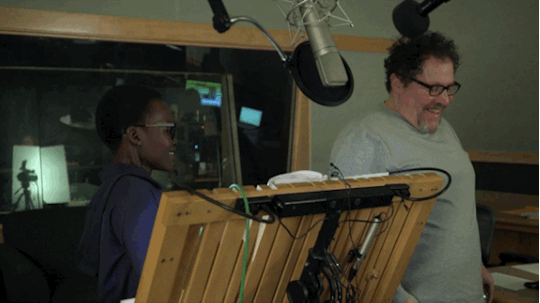
Nyongo’o with Favreau in the studio (Disney)
Adds Esposito: “You’re thinking about what else you can contribute, thinking, ‘What else can I bring to this?’ That made feel as if I was working back in the theater.”
Working on Jungle Book with Favreau was déjà vu all over again for Giancarlo Esposito.
“I came to this as a fan of Kipling,” says the veteran actor. “It was something my mother allowed me to read very young and we would talk about it. The stories have always been in my consciousness. Then, through circumstance, Jon called me to work with him one day. I was happily reading ‘The Law of the Jungle’ for a commercial [for the video game Destiny, below] Jon wanted me to do, and we had this conversation about The Jungle Book.
Watch the Favreau-directed ‘Destiny’ commercial starring Esposito below:
“After we finished, Jon said, ‘Wouldn’t it be wonderful to do this again?’ And then a year later I get a phone call, and he says, ‘Will you be a part of this?’ And I feel very honored. For me it feels synchronous. My mother is 87 now, she’s about to pass away. And it’s something that I can talk to her about — while she’s sill lucid — and to be able to talk to her about this experience and how this happened and how it all came back to her. It’s just a beautiful thing.”
Bill Murray makes a mean brisket.
Sethi happily recounts his trip to visit Murray to record “The Bare Necessities.” “We did get to sing together. So me and Jon Favreau got to fly on a private jet to Martha’s Vineyard to meet Bill Murray. And he made brisket. And we played football. And we ate lobster. It was really good. And then we recorded.”
Christopher Walken makes a great ape.
Favreau let the vocal performances inform the animated creatures to varying degrees. “With Christopher Walken playing King Louie, you actually are pulling data from the performance. I didn’t feel that we’d get the best results if we put the [motion-capture] dots and rigs on [the actors] because it can become distracting, especially if we’re trying to focus on the voice performance. What we did — and thanks to the visual effects wizards — is set up multiple cameras you can extrapolate capture data from that…
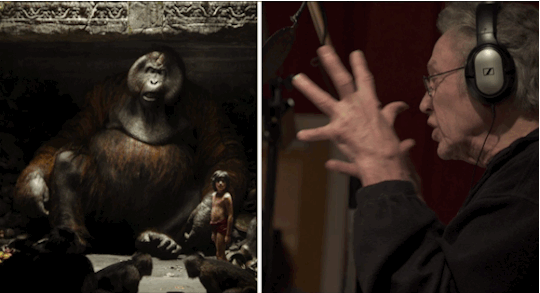
Walken and his on-screen doppelganger (Disney)
“With Sir Ben, we really couldn’t work the eyebrows or the facial expressions because it would look weird on a panther. But we would tend to widen the shots out and pull his performance into the body language as cats do. With the wolves, like with Lupita and Giancarlo, we tended to go in nice and tight because so much of their expression is in their brows.
“The further you get away from the human, the less it matters. For Baloo, if you put too much of Bill Murray’s performance completely on [the bear], you start to hit an uncanny valley. But if you watch Baloo on screen, you will see Bill Murray come through.
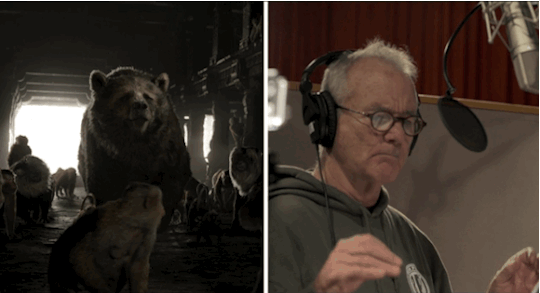
Bill Murray voicing Baloo the bear (Disney)
“When it comes to a snake, there’s no reason to motion-capture Scarlett Johansson’s performance. … The human expressions on a reptile start to look anthropomorphic and weird. We really tried keep the performances within the believability of the animal species.”
There are plenty of Easter eggs.
Fans will have no trouble picking out scenes that echo the 1967 film, but there are several other treats hidden throughout the film. For instance, Rocky the Rhino, a character cut out from the original, is back. But the earlier Jungle Book isn’t the only Disney 'toon that Favreau winks at. The opening sequence riffs on Bambi. There’s a baby elephant shot straight out of Dumbo. The King Louie chase is an homage to the Monstro whale scene in Pinocchio. The climax owes a debt to The Lion King.
Perhaps the neatest touch: Favreau dug through the Disney vaults to find the actual book that opens the original film, and he cleverly brings it back for the closing credits.

Favreau resurrected the original ‘Book’ for the new movie (Disney)
(Come back later this week for a more robust accounting of Easter eggs, callbacks and inside jokes in The Jungle Book.)
Let’s give the last word to Ben Kingsley, because he’s so good.
When told that Jungle Book has scored more than 90 percent on Rotten Tomatoes so far and that the film is tracking toward a huge weekend at the box office, the Oscar winner offered an eloquent explanation.
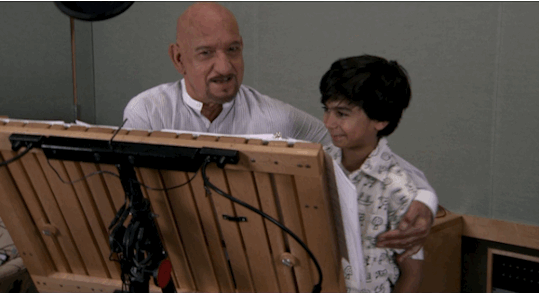
Kingsley and Sethi behind-the-scenes (Disney)
“I have a saying that I’ve made up: If your motives are pure, the angels will come. And I feel that Jon’s motives making this film are so pure. They are the motives of a storyteller. A tribal storyteller that wishes to heal, to comfort, to explain, to entertain, to show the tribe that there are two forces in life: light and shade. This film moves from light to shade, light to shade. It’s an intelligently crafted story but its motives are pure. We pierced the sternum and got through to the heart with this story.”
Disney must agree. News broke this week that the studio is already courting Favreau for a sequel.
Watch ‘The Jungle Book’ featurette:


